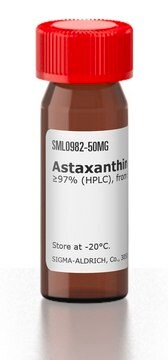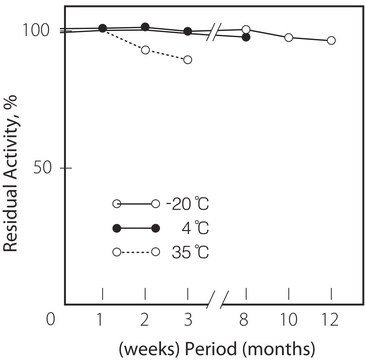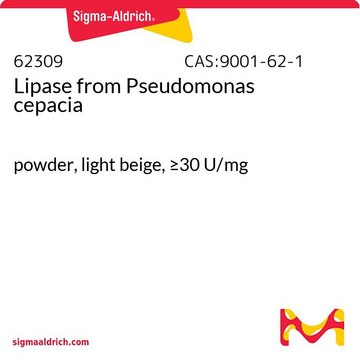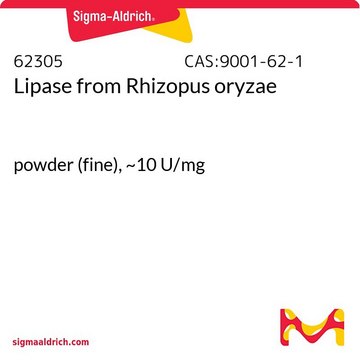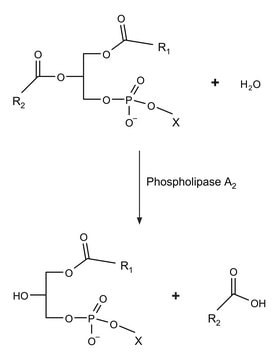C9281
Cholesterol Esterase from Pseudomonas fluorescens
lyophilized powder, ≥10,000 units/g protein
Synonyme(s) :
CE, bile salt-stimulated lipase, cholesteryl ester hydrolase, pancreatic cholesterol esterase, Sterol-ester acylhydrolase
About This Item
Produits recommandés
Source biologique
Pseudomonas fluorescens
Niveau de qualité
Essai
10-30% (TCA-Biuret)
Forme
lyophilized powder
Activité spécifique
≥10,000 units/g protein
Poids mol.
~129 kDa
Composition
Protein, ~20%
Conditions de stockage
under inert gas (argon)
Technique(s)
cell based assay: suitable
Couleur
tan to brown
pH
7-9
Solubilité
0.4 M potassium phosphate, pH 7.0: soluble 1.0 mg/mL
Température de stockage
−20°C
Vous recherchez des produits similaires ? Visite Guide de comparaison des produits
Description générale
Cholesterol Esterase (CE) is a glycoprotein that can be isolated from fungal species such as Candida cylindracea and Pseudomonas fluorescens. It is classified as a member of the lipase/esterase family and functions as a homo-dimeric protein. CE is produced in the pancreas and is released in an active form upon stimulation by Cholecystokinin (CCK).
Application
- in cholesterol esterase assay to quantify total cholesterol from human blood serum samples
- a study to investigate the nondenaturing protein electro transfer of the esterase activity of lipolytic preparations
- an optimization study of components in enzymatic cholesterol reagents containing cholesterol oxidase
- for the modification of human plasma low-density-lipoprotein (LDL) to induce endothelial cell (EC) dysfunction and monocyte (MC) adhesion in the branched tissue-engineered blood vessels (TEBVs)
- to hydrolyze native cholesterol ester (CE) during filipin staining for detection of CE within the retinal frozen sections
Actions biochimiques/physiologiques
Autres remarques
Définition de l'unité
Remarque sur l'analyse
Mention d'avertissement
Danger
Mentions de danger
Conseils de prudence
Classification des risques
Resp. Sens. 1
Code de la classe de stockage
11 - Combustible Solids
Classe de danger pour l'eau (WGK)
WGK 1
Point d'éclair (°F)
Not applicable
Point d'éclair (°C)
Not applicable
Équipement de protection individuelle
Eyeshields, Gloves, type N95 (US)
Faites votre choix parmi les versions les plus récentes :
Certificats d'analyse (COA)
Vous ne trouvez pas la bonne version ?
Si vous avez besoin d'une version particulière, vous pouvez rechercher un certificat spécifique par le numéro de lot.
Déjà en possession de ce produit ?
Retrouvez la documentation relative aux produits que vous avez récemment achetés dans la Bibliothèque de documents.
Les clients ont également consulté
Notre équipe de scientifiques dispose d'une expérience dans tous les secteurs de la recherche, notamment en sciences de la vie, science des matériaux, synthèse chimique, chromatographie, analyse et dans de nombreux autres domaines..
Contacter notre Service technique